With a looming global energy crisis, consumers have had to force themselves to be more financially and environmentally savvy with their financial decisions. We’ve seen an increase in solar panel purchases. However, homeowners can make even more energy savings by combining solar water heaters with heat pumps. But how do heat pumps work? The following guide will answer this question.
What is a Heat Pump
Heat pumps are devices that transfer heat from one area to another. How the heat pump works depends squarely on its type.
How Does a Heat Pump Work
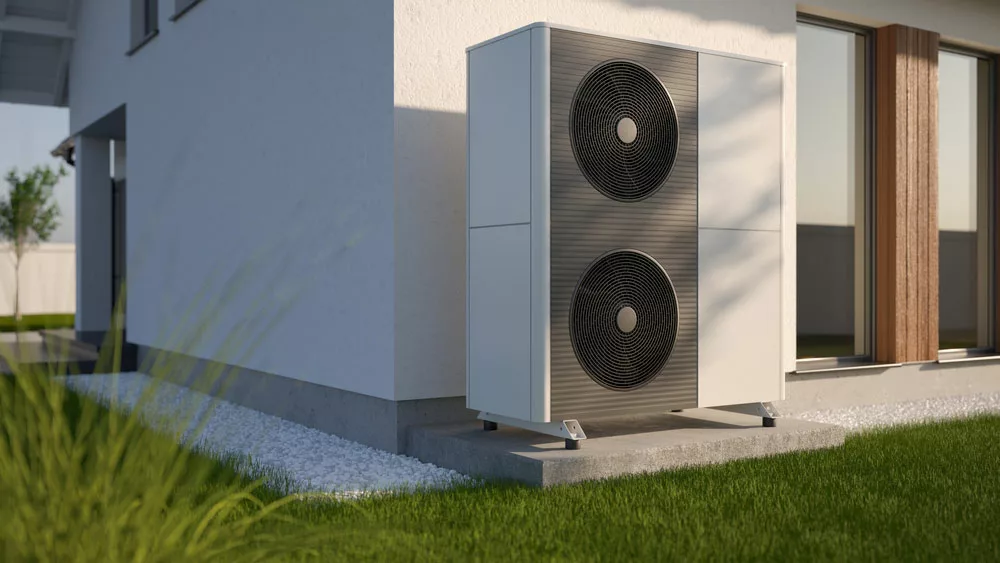
Air-to-air heat pump outside of a house
Since air-to-air heat pumps are the most popular type, this guide will focus on them in this section. Home-grade air-to-air heat pumps look very similar to air-conditioning split units. They consist of two parts; an indoor unit (inside of the house) and an outdoor unit (outside of the house).
Air-to-air heat pumps can work exclusively as heating devices or for cooling and heating through a reversing valve. Most people prefer heating pumps with both a cooling and heating function. Thus, this section will focus on them.
Components of an Air Source Heat Pump
The components of an air-to-air heat pump with a cooling function are as follows:
- Multiple pressure gauges and sensors
- Flow indicators
- Temperature gauges and sensors
- Two thermal expansion valves featuring retention valves and bypasses
- Sight glass
- (fully hermetic reciprocating and scroll compressors)Compressor
- Indoor and outdoor heat exchangers
- Bi-directional, liquid line filter drier
- Controller
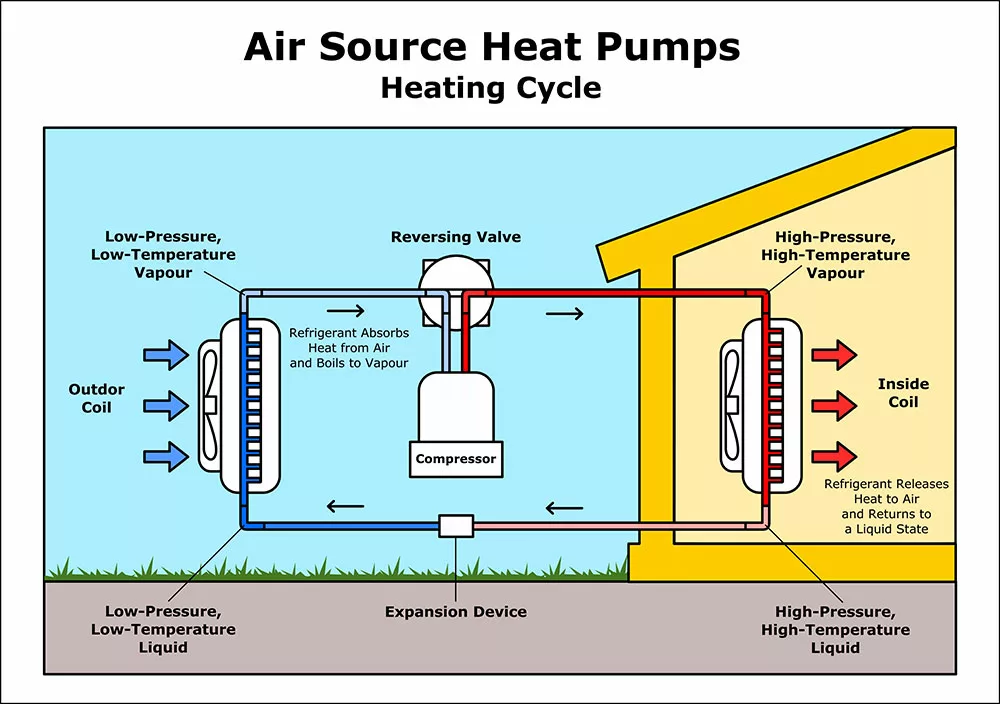
Air-to-Air heat pump heating cycle
Air-to-Air Heat Pump Process Heating Mode
The heating and cooling modes use a vapor-compression refrigeration system (VCRS)- like process. The following section covers how the air-to-air heat pump works in heating Mode.
From Compressor to Heat Exchanger
At the beginning of the cycle, the heat pump’s compressor blasts a high-pressure, high-temperature vapor made from a refrigerant/coolant. The coolant vapor moves through to the reversing valve. The reversing valve then pushes it into the indoor unit, which consists of a coil and fan heat exchanger.
The indoor unit’s fan blasts cool air over the coil. This process transfers a part of the coil’s (and ultimately the refrigerant’s thermal energy) into your home, making your house warmer.
From Heat Exchanger to retention valve
In accordance with the laws of thermodynamics, the gas refrigerant becomes a liquid after losing most of its thermal energy to the indoor heating process. Nevertheless, since it is closed in heating mode, the heat pump’s system guides the coolant past the first thermal expansion valve.
From retention valve to Thermal Expansion Valve
Next, the heat pump system moves the liquid coolant from the retention valve into the liquid line-filter drier and past the sight glass. It will then meet and pass through the second thermal expansion valve. During this process, the retention valve stops the liquid coolant from flowing in the wrong direction.
From Thermal Expansion valve to Outdoor Heat Exchanger
The thermal expansion valve causes the liquid coolant to increase in volume. The coolant then becomes an equal mixture of gas and liquid. This is because the increase in volume decreases the heat and pressure of the coolant. Next, the coolant makes its way to the outdoor unit. The outdoor unit is similar to its indoor counterpart. It consists of a fan and coil heat exchanger. As the coolant passes through the coil, the outdoor unit blasts it with warm/hot outdoor air. Consequently, the coolant gains thermal energy from this process.
From Outdoor Heat Exchanger to Compressor
Refrigerant coolants have lower boiling points. As such, you do not require a lot of energy or a high temperature to get them to boil and change states. Nevertheless, after the heating process is complete, the superheated coolant leaves the outdoor unit and moves to the reversing valve. The reversing valve ushers the coolant into the compressor, where the process begins again.
Air-to-Air Heat Pump Process Cooling Mode
This section covers the cooling mode of the air-to-air heat pump. It works similarly to the heating process.
From Compressor to Outdoor Heat Exchanger
Air source heat pumps in cooling mode work similarly to two-unit air conditioners when you place them in cooling mode. The heat pump’s compressor launches a high-temperature, high-pressure coolant (in gas form) into the reversing valve. This valve then pushes it into the coil of the outdoor unit.
From Outdoor Heat Exchanger to Thermal Expansion Valve
The outdoor unit uses its fan to disperse air across the coolant-containing coil. The coolant is at a higher temperature than the air. Thus, the air will transfer some thermal energy away from the coolant. Once again, this process distills the coolant into a highly-pressurized liquid.
From Thermal Expansion Valve to Indoor Heat Exchanger
The coolant pushes through until it reaches its first thermal expansion valve in this cycle – which is closed. Nevertheless, the coolant bypasses the thermal expansion valve and moves into the retention valve. Again, the retention valve ushers the coolant past the sight glass. It then passes the bidirectional line filter drier until it reaches the second expansion and return valves.
This time the return valve is closed. Consequently, the coolant must pass through the thermal expansion valve this time. The expansion increases the volume of the liquid until it becomes a near-equal mixture of fluid and gas.
In this state, the coolant has less pressure and heat. As such, it’s ready to move into the indoor unit’s coil, where a fan will blow warm air over it. This time the coolant will extract thermal energy from the air. As a result, the coolant heats up to either boiling or near boiling temperature.
From Indoor Heat Exchanger to Compressor
The somewhat superheated coolant moves from the outdoor unit into the reversing valve, which sends the coolant to the compressor. The entire cooling process can begin again from here.
Other Types of Heat Pumps
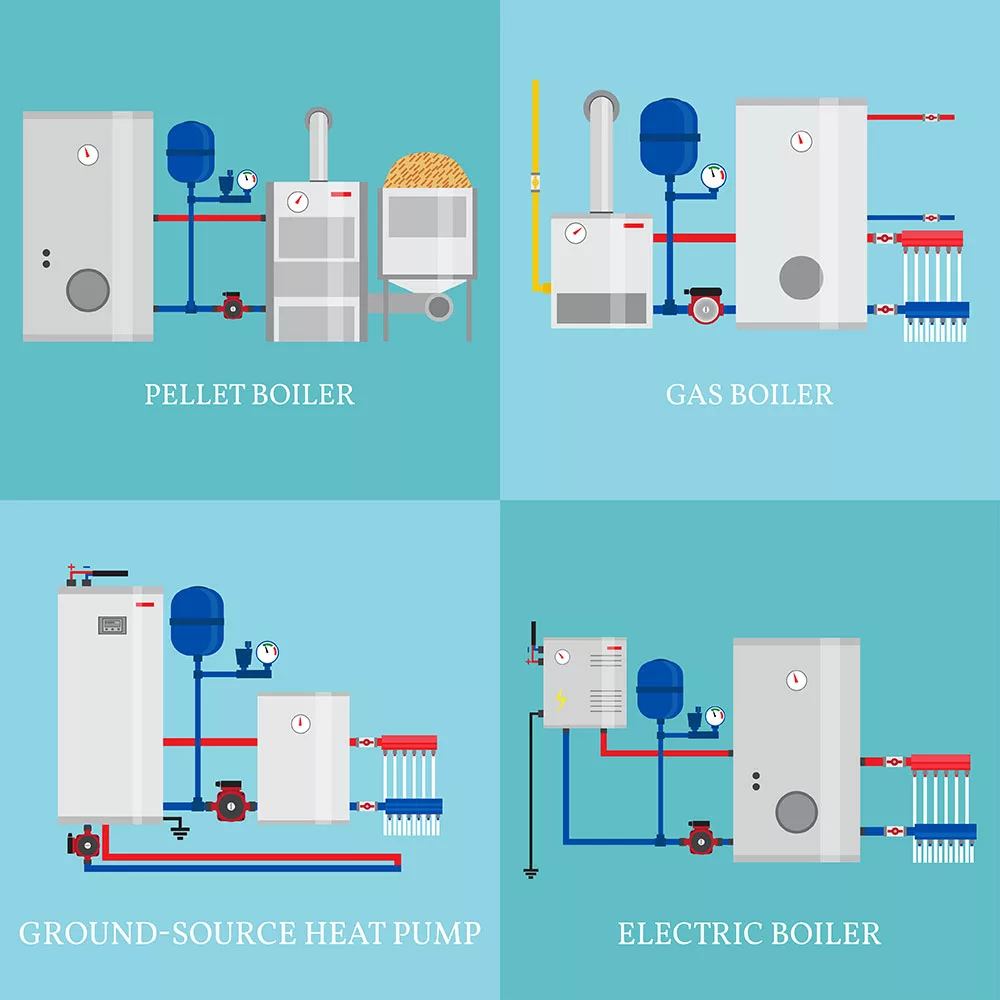
Types of vector images with heat pump types
The four main types of heat pumps are:
- Air Source (air-to-air) Heat Pumps
- Ductless Air Source
- Ducted Air Source
- Geothermal Heat Pumps
- Water-Source Heat Pump
- Ground-Source Heat Pump
- Absorption Heat Pumps
- Oil Heat Pumps
- Gas Heat Pumps
There are also subtypes and hybrids of heat pumps, such as :
- Hybrid Heat Pumps Including:
- Heat Pump with oil/gas boiler option
- Ground and air-to-air heat pump combination
- Solar Heat Pump
There are various types of heat pump systems too. They include:
- Split Systems
- Package Systems
- Mini Split (Ductless)
- Window Heat Pump
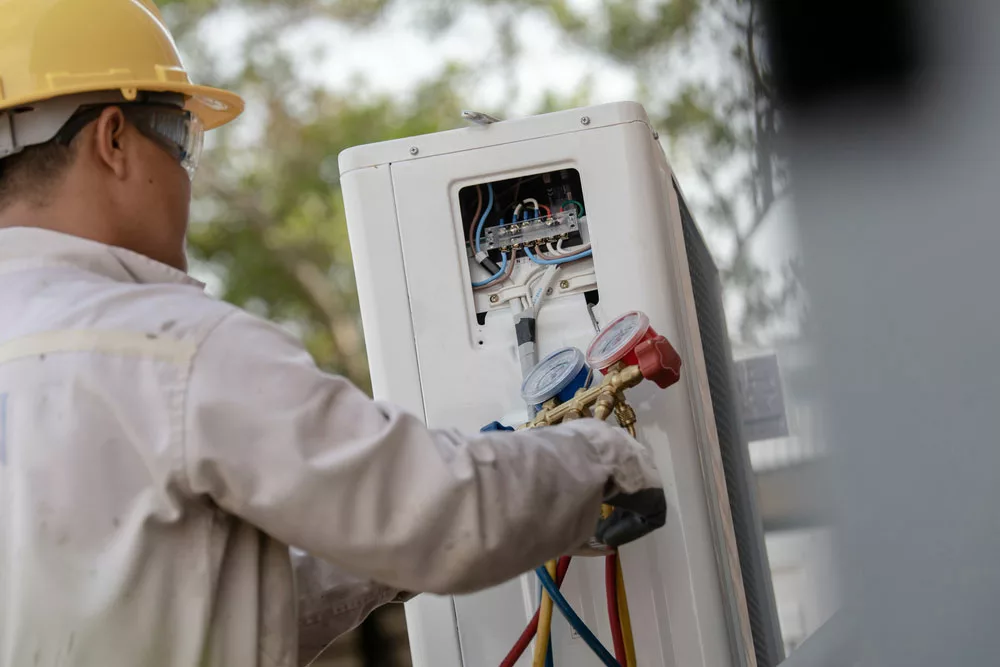
Technician installing a heat pump unit
Pros and Cons of Heat Pumps
Heat pumps come with a set of advantages and disadvantages. Since there are different types of heat pumps, we’ll once again focus squarely on the most popular type – air-source heat pumps.
Pros:
- They can help you save on your gas or oil bill
- Heat Pumps are extremely efficient
- They are easy to use (user-friendly)
Cons
- Causes a slight increase in electricity usage
- You may have to install new radiators for your heat pump system, which can be expensive too
- Heat pumps require stringent planning and can be difficult to install for apartments and other complex housing.
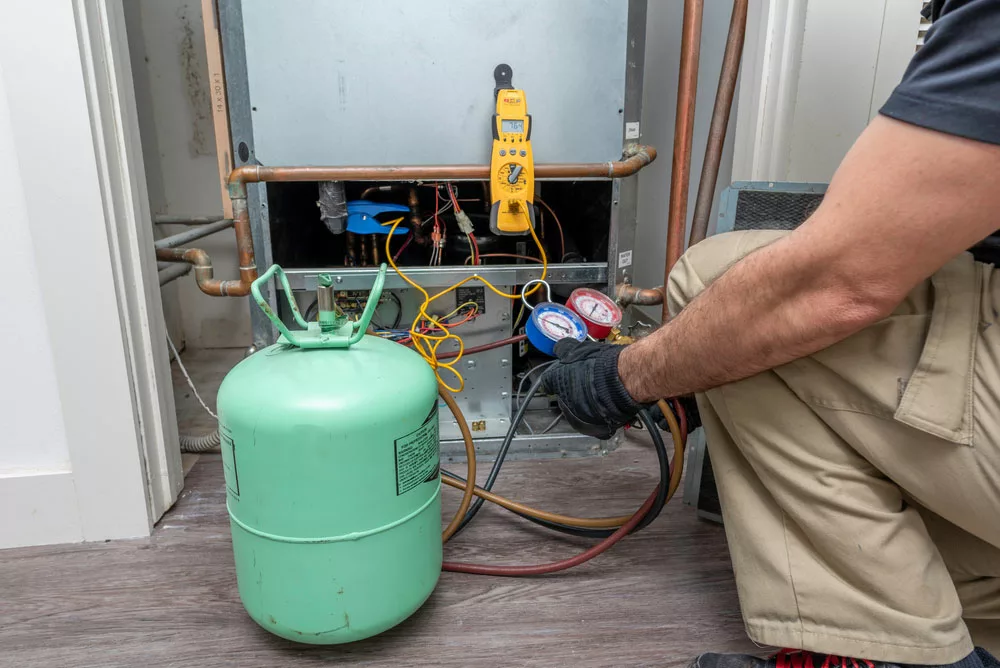
Technician changing heat pump refrigerant
FAQ
Do heat pumps use a lot of electricity?
Heat pumps will raise your electricity bill substantially. Of course, this depends on the model and how often you use the heat pump. Nevertheless, heat pumps can increase your bill by $50 to $100 on average.
Do heat pumps dry your home?
Heat pumps can dry your home and act as dehumidifiers. They ultimately remove the moisture from the ambient air in your home.
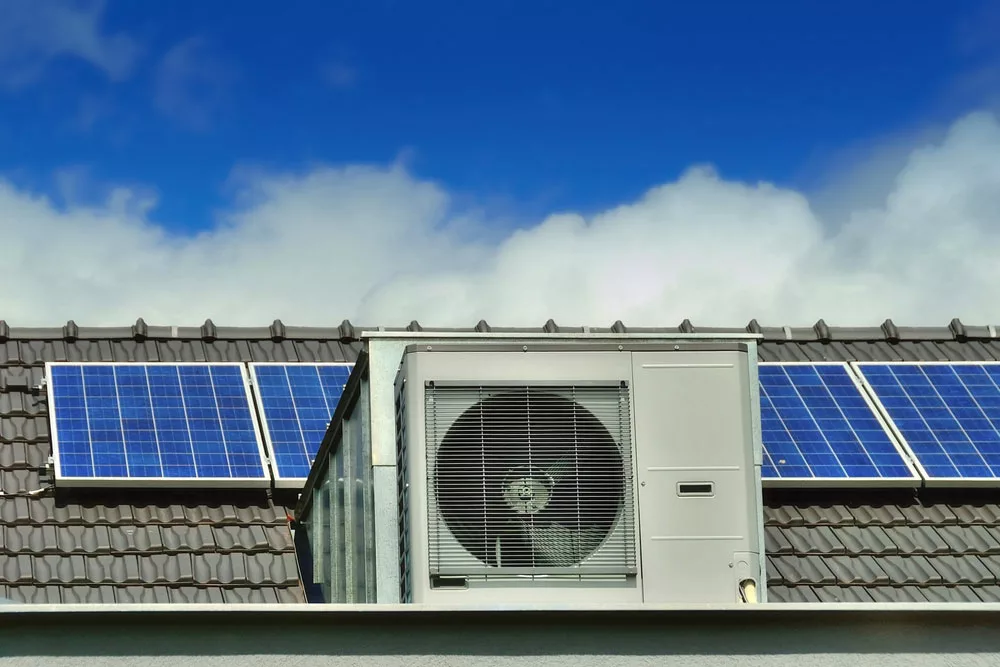
Outdoor heat pump in front of solar panels
How long do heat pumps last?
The average lifespan of a heat pump is 10 to 15 years. However, this depends on how often you use the heat pump. Most people use their heat pumps all year round. This can reduce the lifespan of your heat pump significantly.
Are heat pumps cheaper to run than gas?
While heat pumps will increase your electricity bill, they use their power source far more efficiently than a gas furnace or any other solutions that use fossil fuels. In fact, they deliver more heated energy than the energy they consume.
Do heat pumps need maintenance?
You should regularly maintain your heat pump. This ensures that it runs and uses energy as efficiently as possible. Furthermore, well-maintained heat pumps tend to last longer than those that are not.
Conclusion
The above guide covers how heat pumps work. It mainly focuses on air-to-air heat pumps since they are the most common type. Which heat pump you ultimately choose for your home will depend on the size of your home, the climate, etc. Heat pumps are good alternatives to electric and gas heaters. If you want to learn more about lighting and other electronics for your home, do not hesitate to contact us.
